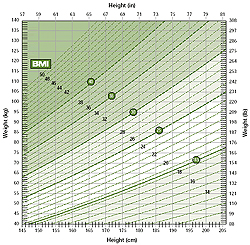The body mass index (BMI) is a rough
approximation of a person's lean body mass. The calculation works best for
those in the middle of the population range of height and weight.
The rule is, weigh and measure the patient
yourself. Don't count on what the patient tells you being
accurate. Especially the height a man is likely to tell you.
- BMI = [Weight (kg)] / [(Height in
meters)2]
- An example of a 200 lb, 6 foot tall man.
- BMI = [91 kg] / [(1.83)2]
- BMI = 91 / 3.35 = 27.2
- Of course, you can get an estimate from
a nomogram without needing to go through the calculation. Click
on the image for a larger and printable image.
- The important thing is to have an
accurate height and weight.
- So what is a healthy BMI?
- <18.5, underwieght
- 18.5 - 25, you're in good shape
- 25 - 29.9, health risks begin
- 30 - 40, serious health risk
- >40, severe health risk.
But nothing beats a good history and
physical exam for assessing nutritional status. It is especially important
to establish a baseline when following someone with a chronic problem.
The most comprehensive and reproducible
method is the Subjective
Global Assessment. |